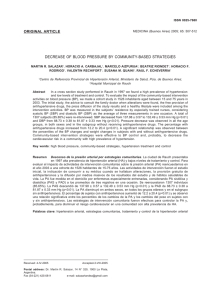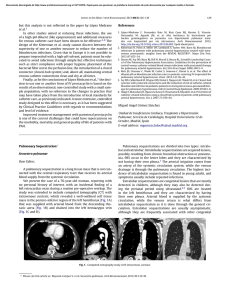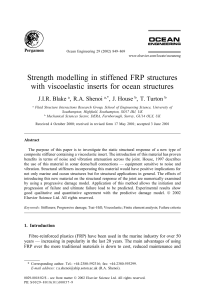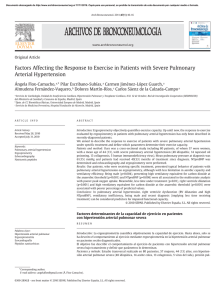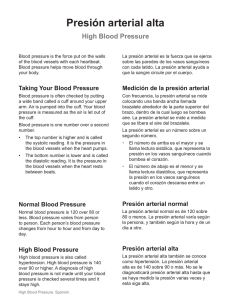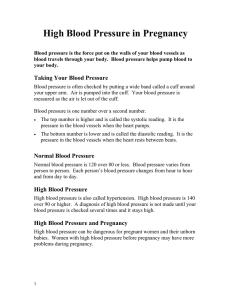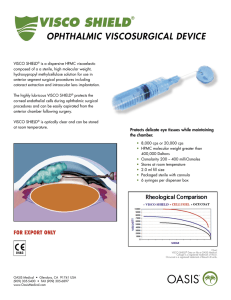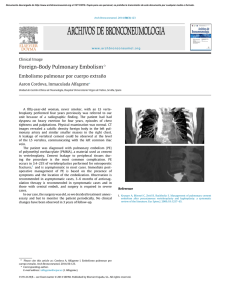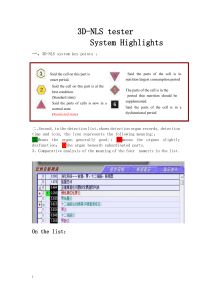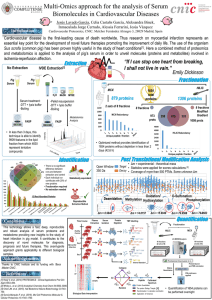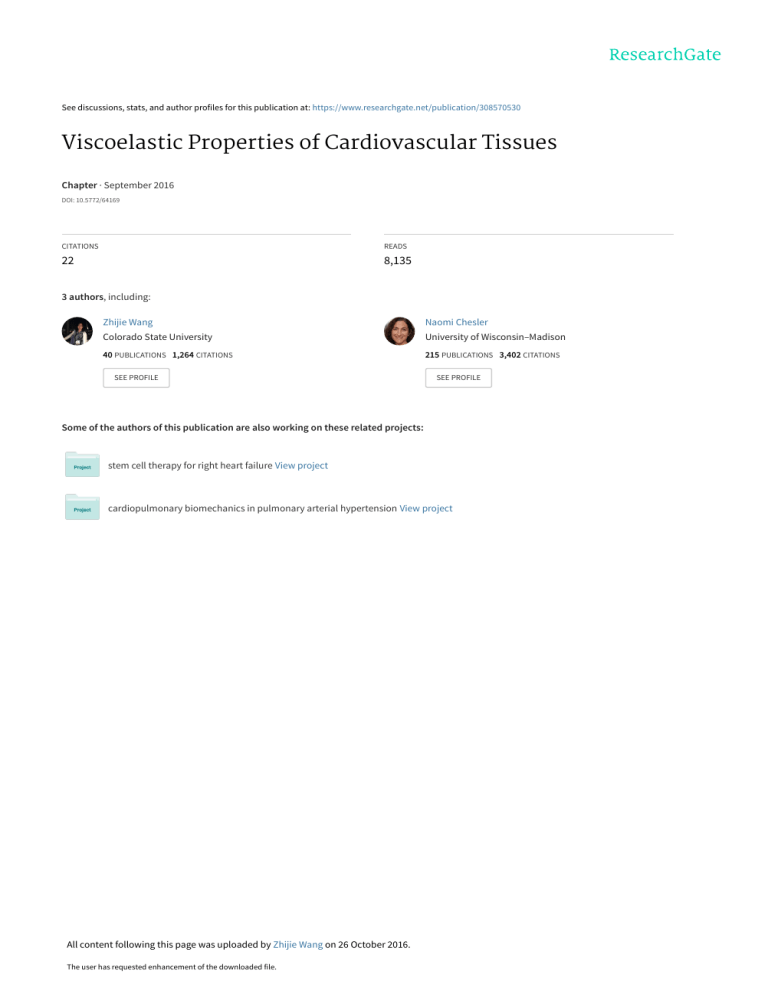
See discussions, stats, and author profiles for this publication at: https://www.researchgate.net/publication/308570530 Viscoelastic Properties of Cardiovascular Tissues Chapter · September 2016 DOI: 10.5772/64169 CITATIONS READS 22 8,135 3 authors, including: Zhijie Wang Naomi Chesler Colorado State University University of Wisconsin–Madison 40 PUBLICATIONS 1,264 CITATIONS 215 PUBLICATIONS 3,402 CITATIONS SEE PROFILE SEE PROFILE Some of the authors of this publication are also working on these related projects: stem cell therapy for right heart failure View project cardiopulmonary biomechanics in pulmonary arterial hypertension View project All content following this page was uploaded by Zhijie Wang on 26 October 2016. The user has requested enhancement of the downloaded file. PUBLISHED BY World's largest Science, Technology & Medicine Open Access book publisher 2750+ OPEN ACCESS BOOKS BOOKS DELIVERED TO 151 COUNTRIES 96,000+ INTERNATIONAL AUTHORS AND EDITORS AUTHORS AMONG TOP 1% MOST CITED SCIENTIST 88+ MILLION DOWNLOADS 12.2% AUTHORS AND EDITORS FROM TOP 500 UNIVERSITIES Selection of our books indexed in the Book Citation Index in Web of Science™ Core Collection (BKCI) Chapter from the book Viscoelastic and Viscoplastic Materials Downloaded from: http://www.intechopen.com/books/viscoelastic-and-viscoplasticmaterials Interested in publishing with InTechOpen? Contact us at [email protected] Chapter 7 Viscoelastic Properties of Cardiovascular Tissues Zhijie Wang, Mark J. Golob and Naomi C. Chesler Additional information is available at the end of the chapter http://dx.doi.org/10.5772/64169 Abstract The aims of this chapter are to review the current state of knowledge regarding the viscoelastic behavior of cardiovascular tissues. We begin with a brief, general discus‐ sion of measurement and modeling of cardiovascular tissue viscoelasticity. We then review known viscoelastic behavior of arteries, veins, capillaries, blood components, the heart, and lymphatics. For each tissue type, we highlight tissue-specific measure‐ ment methods, the cellular and extracellular components responsible for tissue viscoelasticity, and the clinical implications of energy loss due to viscoelasticity. We conclude with a summary and suggestions for future research. Keywords: viscoelasticity, energy loss, blood vessel, heart, lymph system, hemody‐ namics 1. Measurement and modeling 1.1. Experimental measurement approaches Cardiovascular tissues are viscoelastic, exhibiting behaviors that combine features of elastic solids and viscous fluids. Elasticity, viscosity, and viscoelasticity can be quantified from mechanical testing techniques that relate the dynamics of a tissue’s deformation to an applied load. For example, linear elastic materials subjected to an applied load exhibit a timeindependent stress that is linearly proportional to strain (Figure 1a). A common metric of material elasticity is the elastic modulus, E, which is the slope of the stress-strain curve. Materials that are nonlinearly elastic respond differently to different levels of strain and remain time-independent (Figure 1b). In this case, elastic moduli can be defined at any point along the stress-strain curve. In arteries, for example, it is often convenient to quantify the © 2016 The Author(s). Licensee InTech. This chapter is distributed under the terms of the Creative Commons Attribution License (http://creativecommons.org/licenses/by/3.0), which permits unrestricted use, distribution, and reproduction in any medium, provided the original work is properly cited. 142 Viscoelastic and Viscoplastic Materials behavior in low and high strain regions separately and to calculate low and high strain moduli (Elow and Ehigh), respectively [1, 2], which is discussed in Section 2.3. Figure 1 (a) Stress-strain curve for a linear elastic material. (b) Stress-strain curve for a typical elastic material display‐ ing nonlinear behavior. Low-strain and high-strain behavior can be quantified by fitting elastic moduli to those regions of the stress-strain curve. (c) Typical stress-strain curve of nonlinear viscoelastic cardiovascular tissue exhibiting ener‐ gy dissipation resulting in distinct nonlinear loading and unloading curves. (d) Typical hysteresis loops of nonlinear viscoelastic cardiovascular tissue exhibiting strain rate dependence. Linear and nonlinear elastic materials do not dissipate energy after deformation or exhibit time-dependent behavior; therefore, stress-strain behavior of these materials is not different between loading and unloading. In contrast, viscoelastic materials dissipate energy upon deformation, which can be observed through hysteresis in the stress-strain curve (Figure 1c). The energy lost during a loading cycle is equal to the hysteresis area between the loading and unloading curves. Due to this energy dissipation, loading and unloading behaviors are not identical and loading moduli can be determined separately from unloading moduli. Since viscoelastic material behavior is also time-dependent, the loading-unloading stress-strain behavior also depends on strain rate (Figure 1d). To measure viscoelasticity, the strain rate-, frequency-, or time-dependent mechanical behavior of a material must be measured. Often, a sinusoidal input (stress or strain) is applied to tissue, and an output signal (the corresponding strain or stress) is measured. The output signal is in phase with the input signal for a purely elastic material and out of phase for a viscoelastic material. Alternatively, viscoelastic behavior can be quantified with creep and stress relaxation experiments. Creep testing is performed by subjecting a material to a constant load and recording the time-dependent changes in strain. Stress relaxation is conducted by applying a constant strain and measuring the time-dependent stress reduction. Typically, preconditioning is performed before data collection, which is described briefly in the following section. Viscoelastic Properties of Cardiovascular Tissues http://dx.doi.org/10.5772/64169 As a consequence of viscoelastic behavior, the mechanical response to an initial load (force, deformation, stretch, etc.) may differ from the response to a subsequent load. Fung imple‐ mented a preconditioning procedure to cyclically load and unload soft tissue to ensure a more consistent mechanical response [3]. The biological basis for the procedure is that with each subsequent cyclic load, the internal structure aligns with the direction of loading, and the tissue dissipates less energy [4]. The goal of preconditioning is to induce a pseudoelastic state, in which the tissue structure no longer changes with cyclic loading, resulting in a consistent mechanical response to a load or deformation. For instance, preconditioning has been imple‐ mented for up to 40 [5] or 80 [6] cycles in heart valve tissue before stable mechanical responses were observed. If the magnitude of the applied load changes, the internal material structure will change, so the tissue must undergo a new preconditioning protocol [4]. However, it is unclear whether tissues require additional preconditioning if the loading frequency is changed (while keeping the magnitude constant). In mechanical testing of cardiovascular tissues, preconditioning is nearly universally reported in arterial [7–12], heart valve [13, 14], and cardiac [15, 16] tissue. It is important to precondition tissues in order to more accurately estimate viscoelastic properties from single-valued elastic constants (i.e., modulus). Though preconditioning is performed to reduce sample variability, repeated cyclic loading can cause a sample “memory” problem. That is, mechanical behavior during testing can be affected by loading from previous cycles (i.e., testing after preconditioning cycles). To reduce the sample memory problem, researchers have induced rest periods (24 hours vs. 15 seconds) between sets of preconditioned valve samples [17]. This can be accomplished by allowing tissues a recovery period following preconditioning cycles. In heart valve tissues, protocols with a 24-hour rest period between cyclic preconditioning sets had the lowest errors between the predicted model and experimental data [17]. However, the rest periods encompassed several orders of magnitude (in seconds), and it is unknown if an intermediate time is sufficient to reset the strain history. Another study on heart valves reported reduced hysteresis and a stable mechanical response after only a 60-second rest period between two sets of precondi‐ tioning cycles [6]. Therefore, while it is clear that preconditioning is necessary, protocols for cardiovascular tissue viscoelasticity measurements have not yet been standardized. 1.2. Empirical models Using the experimental techniques described above, stress-strain data can be fit to empirical models, which are often useful for predicting viscoelastic material mechanical behavior. Classical models of viscoelastic materials use combinations of spring and dashpot elements to characterize stress-strain behavior. Spring elements represent elastic behavior, where the spring constant of proportionality, k, directly relates the applied force, F, to the resulting deformation, x. Dashpot elements represent viscous behavior, where the applied force is related to the rate of deformation, ẋ, by the viscosity, μ. Spring and dashpot elements are arranged in series in Maxwell models and in parallel in Kelvin-Voight models (Figure 2). Since the elements are arranged in parallel, force in a Kelvin-Voight model is a sum of the two individual element forces, and elements share the same deformation. Conversely, the elements in a Maxwell model share the same force, and the total deformation is the sum of the individual 143 144 Viscoelastic and Viscoplastic Materials element deformations. The combination of spring and dashpot elements in these two models can be used to construct more complex viscoelastic solid models. Additional details on these models and their use are available in Ref. [18]. Figure 2 Maxwell and Kelvin Voight models composed of dashpots and springs. Elements in parallel (Kelvin-Voight model) have the same deformation and separate forces, whereas elements in series (Maxwell model) have the same force and separate deformations. 2. Arteries 2.1. Viscoelastic characteristics of arteries The importance of arterial viscoelasticity is supported by the findings that arterial morphom‐ etry correlates more strongly with pulsatile rather than steady pressure [19] and that dynam‐ ically measured mechanical properties are different from statically measured mechanical properties [20–22] (Table 1). Measuring the viscoelastic behavior of isolated blood vessels can be accomplished by quantifying dynamic length-tension relationships in tissue strips or rings, or pressure-diameter relationships in intact segments either with sinusoidal pressurization [23–25] or step-wise increases in pressure (Figure 3). However, because step-wise pressuriza‐ tion does not accurately mimic the pulsatile blood pressure waveform that arteries experience in vivo (Figure 3), sinusoidal pressurization is a better method for characterizing arterial viscoelasticity. Arterial viscosity, or the damping capacity, can then be obtained from the hysteresis loop [1, 26]. Additional details on arterial mechanical testing methods are available in recent reviews [27, 28]. Arterial viscoelastic properties also depend on the function of the artery (e.g., conduit or muscular), species, and health status (Table 1). Viscoelastic Properties of Cardiovascular Tissues http://dx.doi.org/10.5772/64169 Pulmonary Carotid artery artery [22] [25] Mouse, young Mouse, aged Mouse, aged Dog, young Human, aged Elastic Elastic Elastic Young’s Distensibility modulus modulus modulus modulus 14±2 kPa 116±118 kPa 52±8 kPa 690±48 kPa 3.8±1.4·10−3 mmHg−1 Dynamic 61±3 kPa 118±35 kPa 39±9 kPa 1100±100 kPa 2.1±0.9·10−3 mmHg−1 modulus (at 1 Hz) (at 1 Hz) (at 1 Hz) (at 2 Hz) 0.14±0.01 0.14±0.05 0.06±0.01 ~0.11 ~0.1 [30] (at 1 Hz) (at 1 Hz) (at 1 Hz) (at 2 Hz) (at 2 Hz) Species, age Elasticity Static Aorta* Carotid artery Carotid artery [21] [29] modulus Viscosity Phase angle φ (radians) The viscosity of an artery is presented as the phase difference between the force (stress) and deformation (strain).*Unpublished data. Mean ± SE shown for [22], [25], [29], and *. Mean ± SD shown for [21]. Table 1. Static and viscoelastic circumferential properties measured in conduit arteries. Figure 3 Stair-step and sinusoidal pressure inputs compared to a physiological waveform. 145 146 Viscoelastic and Viscoplastic Materials In healthy arteries, viscoelastic properties are frequency-dependent. In arteries from humans and large animals such as dogs, the dynamic elastic modulus increases over a low-frequency range (<3 Hz) and then remains nearly constant at higher frequencies (up to 10 Hz) [29–32]. The frequency-dependent behavior is different for small animals such as rats or mice; in mouse pulmonary arteries, the dynamic elastic modulus remains constant up to 5 Hz and then starts increasing with increasing frequency (up to 20 Hz) [22]. This discrepancy may be explained by the physiological frequency of the normal heart beat rate, which is largely species sizedependent. In large animals and humans, the normal heart rate is ~1 Hz, whereas in small animals, the heart rate is ~5–10 Hz. Therefore, if scaled to the physiological frequency, we can conclude that the arterial dynamic modulus increases rapidly at 2- to 3-times the natural heart rate and then plateaus at higher frequencies (10- to 20-times higher than the natural heart rate) [22]. In terms of viscous properties, the phase lag of energy dissipation increases as frequency increases in all species [22, 29, 30]. 2.2. Contribution of smooth muscle cells While it is generally agreed that elastin and collagen are responsible for the nonlinear elasticity of arteries, the cellular and molecular determinants of arterial viscoelasticity remain incom‐ pletely understood. Early experimental data comparing carotid and femoral arteries showed a higher viscosity in femoral arteries, and the investigators hypothesized that the higher smooth muscle cell (SMC) content in the femoral artery is responsible [29, 30]. However, there was no measurement of SMC content or activity in these studies. Recent evidence suggests that SMC activity is key to arterial viscoelasticity because removal of SMC tone reduces damping [33, 34] and activation of SMC contraction by phenylephrine or renovascular hypertension in dogs and sheep increases damping [35–37]. Therefore, both SMC content and SMC tone play important roles in arterial viscosity and viscoelasticity. 2.3. Contribution of extracellular matrix The role of extracellular matrix (ECM) components in arterial mechanical behavior is originally evidenced in the nonlinear elasticity curve, which arises from differential load-bearing contributions of ECM proteins. Specifically, the protein elastin dominates load-bearing in the low-strain region whereas at higher strains, collagen fibers, which impart strength and stiffness, are engaged. The transition region in between occurs because increasing strain causes collagen fiber alignment and recruitment resulting in a transition from increasing collagen engagement to collagen-dominated load-bearing. Therefore, ECM proteins are critical to arterial nonlinear elasticity. ECM proteins and cell-ECM interactions may also play important roles in arterial viscoelas‐ ticity. Collagen and proteoglycans are known to affect energy loss in tendon and cartilage [38– 41]. In the first measurements of mouse pulmonary arterial viscoelasticity, Wang et al. [22] found supporting evidence that collagen and proteoglycans affect frequency-dependent changes in arterial damping capacity. Similarly, in carotid artery strips, Garcia et al. [42] found evidence that elastin is an important contributor to stress relaxation. Viscoelastic Properties of Cardiovascular Tissues http://dx.doi.org/10.5772/64169 The contribution of ECM components to tissue viscoelasticity is best studied through single ECM protein degradation or tissue decellularization. The viscoelastic behavior of elastin was studied using a cyanogen bromide treatment, which removes cells and all ECM components except elastin [43]. In this experiment, stress-relaxation was highest in intact aortas, inter‐ mediate in decellularized ECM, and lowest in cyanogen bromide-treated aortas, i.e., arterial elastin. Interestingly, the creep behavior of the aorta in all the three aforementioned groups was negligible. Our group has found that increased expression levels of collagen and proteoglycans are associated with increased pulmonary arterial stiffness and decreased damping capacity [22]. Since we did not investigate the independent effects of proteoglycan and collagen content on pulmonary arterial viscoelasticity, both proteins may be involved. Furthermore, the concom‐ itant changes in these ECM proteins and arterial viscoelasticity and lack of changes in SMC content, coupled with the absence of SMC tone, suggest that these ECM proteins are critical to arterial viscoelasticity in a way that has not been previously described. Future investigations should clarify the roles of individual ECM protein and the ECM-fibril interaction or cell-ECM interaction in arterial viscoelasticity. 2.4. Effects of aging and hypertension With aging or hypertension, arteries become less distensible [44, 45]. This is mainly associated with changes in the ECM proteins collagen and elastin. It is well known that fragmentation of elastin and degeneration of collagen occurs with age in arteries [45]. In addition, the degree of cross-linking of the ECM proteins increases. These changes lead to a higher elastic modulus. Hypertension and arterial stiffening are closely associated with age; however, arterial stiffness is an independent prognostic factor for cardiovascular outcomes [46]. Indeed, recent investi‐ gations have reported that arterial stiffening precedes blood pressure elevation [45]. The causeand-effect relationship between hypertension development and arterial stiffening remains a key knowledge gap in current investigations [47, 48]. The changes in conduit arterial viscosity during aging and hypertension remain incompletely understood. From in vitro isobaric experiments on human aorta or mouse pulmonary artery, viscosity of the arterial wall has been found to decrease in these conditions [22, 30]. However, inconsistent findings are reported elsewhere. In vitro studies on rat aorta found increased viscosity with aging [49]. In another case, in vivo measurements have shown increased pulse damping (or viscosity) as hypertension develops [33, 34, 37]. In these in vivo studies, the dynamic responses of healthy and hypertensive arteries were measured under different pressure ranges due to the developing disease. It is known that arterial viscoelasticity is dependent on the pressure level: as the pressure increases gradually, arterial stiffness and viscosity both increase [50]. Therefore, the shift and deformation of the stress-strain hysteresis loop are a combined effect of changes in intrinsic mechanical properties and extrinsic pressure/ stretch ranges, which must be taken into account when interpreting dynamic mechanical testing data. 147 148 Viscoelastic and Viscoplastic Materials 2.5. Hemodynamic and cardiac consequences The impact of large, conduit arterial viscoelastic properties on cardiovascular hemodynamics has not been well studied. As noted above, arterial stiffening (i.e., decreased elasticity) is a useful prognostic indicator of cardiovascular events [51, 52] and is well known to contribute to increased ventricular afterload [53–55]. Increased stiffness may also impair wave reflections, which further augment the ventricular afterload [56, 57]. The energy dampening function achieved through arterial viscosity is beneficial in normal physiological conditions because it absorbs the energy from the wave reflections. In sheep with acute pulmonary hypertension, an SMC activation-mediated increase in pulmonary arterial viscosity led to a decrease in wave reflections and increase in characteristic impedance (the vascular impedance that represents the opposition to pulsatile flow), thus reducing the fraction of oscillatory to total right ventricular hydraulic power and improving hemodynamic function [58]. In the mouse extralobar pulmonary arteries, our group found a decrease in arterial damping capacity as pulmonary hypertension developed [22]. We speculated that the reduced viscosity may be in part responsible for the increased pulse wave velocity and pulse pressure during pulmonary hypertension progression [59], which eventually increased pulsatile right ventricular afterload. Additional clinical studies are needed to elucidate the implications of arterial viscosity for cardiovascular hemodynamics. Also, elasticity and viscosity are coupled behaviors in an artery, yet the relationship between them is rarely reported. The investigation of the inde‐ pendent and interdependent impacts of arterial elasticity and viscosity on cardiovascular function could be an important area for future research. 2.6. Use of an arterial viscoelasticity index for clinical diagnosis A novel index of arterial viscoelasticity, which was measured in a large scale, clinical study, is worthy of special mention. Taniguchi et al. [60] used noninvasive methods to assess carotid artery viscoelasticity in 383 patients. The authors defined a nondimensional parameter I* derived from the ratio of the gradients of vascular wall deformation rates during deflation and inflation over a cardiac cycle, in which I* < 0 indicates healthy viscoelasticity whereas I* > 0 indicates abnormal viscoelasticity. A positive I* was found in female, elderly (>60 yr), and hypertensive (blood pressure > 140 mmHg) subjects and was a significant, independent risk factor for coronary artery disease based on univariate and multivariate analyses [60]. While this parameter is only an indirect measure of arterial viscoelastic behavior and its physical meaning requires further investigation, it is noteworthy that this index can be measured noninvasively through ultrasonic Doppler [60, 61]. In order to better understand the clinical significance of arterial viscoelasticity, it is crucial to assess arterial viscoelasticity in more patient populations, with additional measurement parameters. Research like this may establish new, useful viscoelasticity indices that aid in clinical diagnosis and prognosis. Viscoelastic Properties of Cardiovascular Tissues http://dx.doi.org/10.5772/64169 3. Veins Vein biomechanics are understudied compared to arterial biomechanics, and there is a general lack of understanding of venous viscoelasticity. That said, the venous wall is structurally similar to the arterial wall with less muscle and elastic tissue, resulting in thinner walls that are more compliant and collapse easily [62]. Thus, venous viscoelasticity likely shares several features in common with arterial viscoelasticity, including a dependence on SMC content and tone and the ECM proteins collagen, proteoglycans, and elastin. The measurement methods for venous viscoelasticity are identical to those for arterial viscoelasticity. Vein viscoelasticity is clinically relevant to coronary artery bypass grafting, which often uses saphenous veins to replace diseased coronary arteries, since coronary artery perfusion is critical to myocardial health. Venous viscoelasticity is an important and largely unexplored area for future research. 4. Capillaries Capillaries are very thin microvessels that are composed of a single layer of endothelial cells. Capillary beds serve as the location for the exchange of gases and nutrients between blood and tissues. Because of the delicate structure of the capillary wall, it is impossible to isolate the capillaries without injury. To obtain the stress-strain relationship for capillaries, capillary dimensions can be measured by microscopy imaging while the local intravascular pressure can be altered and measured by micropuncture [63], occlusion of upstream (arterial) and downstream (venous) vessels [64] or controlled perfusion [65]. Like other types of blood vessels, the capillaries exhibit nonlinear stress-strain behavior [64] and viscoelastic features like creep and relaxation [65]. In normal conditions, the distensibility of the capillary vessels is in between the small arteries (arterioles) and small veins (venules), and the viscosity is the least in capillary vessels in a passive creep test in rats (i.e., without smooth muscle tone in the arterioles and venules) [65] (see Table 2). Like venous viscoelasticity, capillary viscoelasticity is a largely unexplored area for future research with unknown clinical relevance. Arcade arterioles Capillary Arcade venules α1 (×10 mmHg) 6.34±3.59 7.42±3.00 9.52±3.24 β (×104 mmHg s) 4.25±4.17 3.00±2.25 5.52±3.16 2 The experimental data were fitted with a three-element linear solid viscoelasticity model. Coefficients α1 and β represent the elastic and viscous characteristics, respectively. Mean ± SD shown. Adapted with permission from Skalak et al. [65]. Table 2. Viscoelastic properties measured in rat arterioles, capillary vessels, and venules using a single-step creep test (pressure = 50 mmHg). 149 150 Viscoelastic and Viscoplastic Materials 5. Blood components Blood is a non-Newtonian, viscoelastic fluid made up of cellular components, including erythrocytes (red blood cells, RBCs), leucocytes (white blood cells), and thrombocytes (plate‐ lets), and a fluidic component called plasma. The volume percentage of all blood cells in whole blood is about 45% in adult men. The viscoelasticity of blood depends on the hematocrit (volume fraction of RBCs) in whole blood, plasma viscosity, and aggregation and mechanical properties of blood cells. The deformability of blood cells plays an important role in their main functions as well as the blood rheology and hemodynamics [66, 67]. While the viscoelasticity of blood cells, including RBCs [66–68] and white blood cells [69, 70], has been studied, here we will discuss only RBCs since they have the highest concentration in whole blood and are the most relevant to hemodynamics under most physiological and pathological conditions. The RBC is a simply structured biological component that consists of a bilayer membrane and thin cytoskeleton of spectrin filaments [68]. Mammalian RBCs lack a cell nucleus. RBCs exhibit a unique deformability, which enables them to change shape reversibly in response to an external force (e.g., under the stress applied by the capillary wall). Despite the structural simplicity of RBCs, the understanding of their mechanical properties is still incomplete. The viscoelastic properties of RBCs, which are key determinants of RBC deformability, can be classified into elastic (or storage) and viscous (loss) moduli: the shear modulus that describes the uniaxial elongation property, the area expansion modulus that describes the changes in RBC membrane area, the bending modulus that describes the bilipid layer associated with resting shape changes, and the viscosity that describes the rate of deformation of RBC membrane [71, 72]. Typical methods for viscoelasticity measurement of single or multiple RBCs were recently reviewed [71] and include micropipette aspiration, atomic force microscopy, optical tweezers, fluid or microfluidic filtration, and laser diffractometry. RBC viscoelasticity is closely related to blood rheology and hemodynamics [66, 67]. For example, reduced RBC viscoelasticity leads to a significant increase in microvascular flow resistance and blood viscosity [67, 71]. Exchanging native RBCs with RBCs hardened with glutaraldehyde causes a doubling of the filtration resistance and reduced flow in rats [67]. Altered RBC viscoelasticity is frequently reported in pathological conditions such as diabetes [73, 74], hyperglycemia [74, 75], and sickle cell disease [76]. While cardiovascular complications including arterial stiffening, heart failure, or stroke are often associated with these diseases [77, 78], it is possible that the altered RBC mechanics may exert an impact on overall hemodynam‐ ics, which is a critical contributor to cardiovascular health. Further understanding of the influence of RBC viscoelasticity on cardiovascular hemodynamics could inspire novel therapies that target the biomechanical mechanism of the disease. Viscoelastic Properties of Cardiovascular Tissues http://dx.doi.org/10.5772/64169 6. The heart 6.1. Heart valves Viscoelastic behavior has been demonstrated to different degrees in native or pericardial-based heart valve tissues, which are usually made up of highly organized ECM and valve interstitial cells. Though direct comparisons cannot be made between studies with different testing methods, viscoelastic characteristics including strain-rate dependence, stress relaxation, and creep have been observed after loading of valvular tissue from ex vivo mechanical testing. Similar to arterial tissue discussed above, interestingly, mechanisms of stress relaxation appear to be distinct from those of creep. For example, stress relaxation observed in valvular tissue was accompanied by negligible creep over a 3-hour timeframe [79]. Therefore, use of multiple modalities for valve tissue viscoelastic property measurement is recommended. As with arterial tissue, valvular viscoelastic behavior is dependent on ECM components. In heart valves, collagen in particular has a complex fiber alignment pattern that appears to generate more viscoelasticity in the circumferential direction compared to the radial direction [80]. Imaging techniques including scanning electron microscopy and bright field or polarized light microscopy have demonstrated that collagen fibers are highly aligned in the circumfer‐ ential direction but more randomly distributed in the radial direction. Therefore, a more highly aligned fiber structure likely contributes to larger degree of viscoelastic behavior. Also, the effect of preconditioning has been shown to be direction-dependent with the circumferential direction displaying a more consistent mechanical response after a fewer number of cycles [80]. This indicates that an initially aligned fiber structure will achieve a consistent mechanical response faster than randomly oriented fibers. Like arteries, heart valves exhibit less creep than stress relaxation [81]. This behavior seems to be unique to collagen-rich soft biological tissues like ligament [82] and cornea [83]. The underlying mechanism is not fully understood. Thornton et al. [84] attribute it to different mechanisms involved in the two tests. In particular, these authors suggest that the stress relaxation response is determined by a discrete group of ECM fibers recruited at constant elongation, whereas the creep response is determined by different fibers being progressively recruited at constant stress. Another hypothetical mechanism is the ‘fibril-locking’ mechanism that collagen fibrils maintain under a constant stress, whereas under a constant strain the fibril stress decreases [81]. The interactions between collagen and proteoglycans also have been proposed to affect tissue viscoelasticity in heart valves [79, 85]. Not surprisingly, the chemical treatments of valvular tissue that are used prior to bioartificial heart valve replacements have been shown to affect viscoelastic behavior. Glutaraldehyde fixation reduces the immune response and prevents leaflet degradation but can induce ECM cross-links and other structural changes [86, 87] that reduce radial stiffness and increase extensibility [86, 88] as well as reduce creep and stress relaxation [13, 86, 88, 89]. Fixation also increases the number of preconditioning cycles required to achieve a consistent mechanical response in dynamic mechanical testing [88]. These effects can be minimized with pressure 151 152 Viscoelastic and Viscoplastic Materials fixation, which results in more similar viscoelastic behavior in fixed tissues compared to untreated tissues [88]. The decreased stress-relaxation that occurs in heart valve tissues treated with glutaraldehyde has important implications for bioprosthetic heart valves because the industry standard of accelerated wear testing (AWT) is used to determine the absolute fatigue life of bioprosthetic heart valves. In AWT, valves are cycled at frequencies higher than the normal heart rate (up to ~30 Hz). With reduced stress-relaxation, the valve may not have time to relax to its natural state, resulting in a higher preload for each subsequent cycle [13]. A better understanding of heart valve viscoelasticity and the molecular basis for tissue viscoelastic properties could improve bioprosthetic valve design and testing. 6.2. Myocardium Ventricular myocardial tissue exhibits viscoelastic characteristics, which are changed in diseased states. Viscoelastic properties have been examined in the healthy swine myocardium using noninvasive shear wave velocity techniques [90]. Briefly, external actuators are used to create and propagate waves in the myocardial wall; the velocity is measured at several frequencies, and these data are fit to empirical viscoelastic models described in Section 1.2. Human myocardium tissue tested ex vivo exhibited multiple viscoelastic characteristics including directional-dependent hysteresis and stress relaxation, and rate-dependent stressstrain curves [16]. The subjects from whom tissues were harvested had various causes of death, so the data cannot be interpreted in the context of healthy versus diseased states. However, several studies have shown changes in viscoelastic properties with disease. The use of a KelvinVoight model demonstrated that elastic and viscous damping constants increased in the pressure-overloaded feline right ventricle [91]. Similarly, elastic and viscous constants increased in the pressure-overloaded rat left ventricle [92]. An important future direction is to assess the viscoelastic behavior in healthy versus diseased myocardium and determine the impact on cardiac performance. The structural basis of myocardial viscoelasticity can be attributed to a combination of cardiac cells and ECM proteins, but the nature and extent of each component’s contributions to viscoelasticity are still debated. Myocardial tissue is composed of cardiac cells or myocytes. Myocytes are composed of repeating units called sarcomeres, which contain titin, actin, and myosin proteins. By isolating cardiomyocytes from surrounding ECM structures, viscoelastic properties can be measured. Uniaxial testing of myocytes revealed force-length hysteresis [93], indicating they are one source of viscoelasticity. Titin functions as a spring, and titin-actin interactions may contribute to viscoelastic behavior [94]. Cardiac cells are surrounded and consequently interconnected by ECM proteins to provide structural integrity to the heart. Evidence that collagen degradation is accompanied by decreased elastic stiffness and viscous damping suggests that collagen plays an important role in myocardial viscoelasticity [91]. Collagen accumulation (or fibrosis) is a characteristic of failing ventricles and with hypertro‐ phic remodeling the collagen content can increase by ~50% [95]. Therefore, it may be important to investigate the effect of collagen accumulation on myocardium viscoelasticity during heart failure development. Viscoelastic Properties of Cardiovascular Tissues http://dx.doi.org/10.5772/64169 Importantly, the majority of myocardial viscoelastic properties are reported from the left ventricle, and differences in viscoelastic behavior between ventricles are unknown. The left ventricle differs embryologically, geometrically, and structurally from the right ventricle [96– 98], so results from the one cannot be extrapolated to the other. Indentation testing ex vivo showed similar baseline levels of elastic and viscous constants between both ventricles in rats [92]. Differences in viscoelastic properties between ventricles will be important directions for future research to understand the role of viscoelasticity in healthy and diseased myocardial function. 7. The lymphatic system The lymphatic system is the third circulation in the human body and is complementary to the first two: the systemic and pulmonary circulations. It consists of branched lymphatic vessels that collect and transport lymph fluid as well as organs (e.g., lymph nodes, spleen, and thymus) that assist with lymph transport. When pressure is greater in the interstitial fluid than the tiny, closed-end lymphatic capillaries, lymph flows in [99] and is transported to gradually larger lymphatic vessels, collected and filtered through lymph nodes, and finally enters the lymphatic duct where it is Reintroduced into the bloodstream. The ontogenesis of lymphatic vessels is not fully understood but some evidence suggests that they are derived from the veins [62]. Lymphatics are often compared to veins because both are thin walled, valved structures and their main function is to transport fluid (blood or lymph) for nutrition and immune purposes, respectively. Despite of their structural similarity to blood vessels, lymphatics are different in several aspects. First, at a similar distance from the heart, lymphatics are larger and thinner than veins [62]. Second, lymphatics are subjected to lower pressures than veins and have more compliant walls [62, 100, 101]. Third, unlike the veins in which the blood is conducted only passively to the heart as a result of valve action and in combination with the intermittent compression by adjacent tissue, lymphatics have both extrinsic and intrinsic pumping mechanisms [101, 102]. Both experimental studies and mathematical modeling have been done to characterize lymphatic pump function [103–105]. For instance, incorporating experimental measurements of a mesenteric lymph vessel, Bertram and Moore developed a model to capture intrinsic pumping function [102]. Similar to arteries and veins, chronic changes in pressure and flow can cause remodeling of lymphatics [101]. For example, lymphatic pumping weakens in response to venous hypertension [106]. The active pumping function can be impaired due to metabolic disorders, local immune-compromise, and lymphedema [104]. Few studies have been performed on the viscoelasticity of lymph vessels. Ohhashi [100] compared the viscoelastic properties of bovine mesenteric lymph vessel, which is considered as muscular lymphatics because of the rich and well-developed SMC content, to the canine thoracic duct, which is considered a fibrous lymphatic because of the lower SMC content and higher elastin and collagen content in the wall. They found that the muscular lymphatic vessel 153 154 Viscoelastic and Viscoplastic Materials is more compliant, and its hysteresis loop is wider than that of the fibrous thoracic duct, suggesting a larger viscosity due to more layers of SMCs. Because lymphatic pumping is critical to lymph transport and lymphatic viscoelasticity likely affects lymphatic pumping, understanding the determinants of lymphatic viscoelasticity and its impact on pumping function may unveil new mechanisms for lymphatic dysfunction. The viscoelastic properties of another main component in the lymph system – the lymph node – have been recently reported. McClain et al. found that lymph node tissue becomes stiffer and has increased energy loss with cancerous tumor development in mice [107]. While the finding is novel and exciting, it raises more questions such as how changes in lymph node viscoelastic properties relate to tumor regression, antitumor immune response, or metastatic colonization of the lymph node. 8. Summary An improved understanding of cardiovascular tissue viscoelastic properties and their de‐ pendence on cardiovascular tissue structure will no doubt provide valuable insights into the functional behavior of these tissues. More importantly, despite the long-standing recognition that cardiovascular tissues are nonlinearly elastic and viscoelastic materials, the clinical implications of cardiovascular tissue viscoelasticity remain poorly understood. In the example of arterial viscoelasticity, inconsistent findings of arterial viscoelastic changes with disease and a lack of tools for simple and easily accessible clinical measurement have likely contributed to a lack of information on the impact of arterial viscoelasticity on cardiovascular hemodynamics and cardiac function. Therefore, there is a pressing need to elucidate the clinical implications of cardiovascular tissue viscoelasticity in disease progression in future research. We recommend the following as promising and impactful future areas of research: 1. Protocols for preconditioning: It is well accepted that preconditioning is necessary for mechanical property measurements. The most appropriate protocols for preconditioning tissues subjected to different testing frequencies and different strain ranges is unclear, however. Also, the sample 'memory' behaviour should be investigated to standardize mechanical testing protocols for cardiovascular tissue viscoelasticity measurements and reduce sample variation. 2. Structural models that include viscoelasticity: The rapid development of arterial structural models has advanced the understanding of the structural-functional relationship of arteries in ways that empirical, phenomenological models cannot. However, current models predict static mechanical behavior only. Future structural models should incor‐ porate elements that are responsible for viscous behavior and predict cardiovascular tissue dynamic mechanical behavior. 3. Creep vs. stress relaxation behaviours: The mechanisms that lead to differences in creep and stress relaxation behaviours are not fully understood. Investigating these character‐ Viscoelastic Properties of Cardiovascular Tissues http://dx.doi.org/10.5772/64169 istics in different cardiovascular tissues would improve our understanding of tissue viscoelastic behavior. 4. Structural determinants of viscoelasticity: The contributions of cells (e.g., SMCs, endo‐ thelial cells, or myocytes), ECM (e.g., elastin, collagen, or proteoglycans), and cell-ECM interactions to tissue viscoelasticity are not fully understood. Modern high spatial and temporal resolution imaging techniques (e.g., multiphoton microscopic imaging) will provide insight into the ways in which cardiovascular tissue structures generate viscoe‐ lastic function. 5. Hemodynamic and cardiac impact of viscoelasticity: Arterial stiffening is known to occur in aging and hypertension and predict heart failure. Future research should investigate the impact of arterial viscoelasticity on cardiovascular disease development and progres‐ sion. Author details Zhijie Wang, Mark J. Golob and Naomi C. Chesler* *Address all correspondence to: [email protected] University of Wisconsin – Madison, Madison, Wisconsin, USA References [1] Wang Z , Chesler NC. Role of collagen content and cross-linking in large pulmonary arterial stiffening after chronic hypoxia. Biomech Model Mechanobiol. 2012;11(1–2): 279–289. [2] Tabima DM , Chesler NC. The effects of vasoactivity and hypoxic pulmonary hyper‐ tension on extralobar pulmonary artery biomechanics. J Biomech. 2010;43(10):1864– 1869. [3] Fung YC , Fronek K, Patitucci P. Pseudoelasticity of arteries and the choice of its mathematical expression. Am J Physiol. 1979;237(5):H620–H631. [4] Humphrey JD , DeLange S. An Introduction to Biomechanics: Solids and Fluids, Analysis and Design: Springer-Verlag New York; 2004. [5] Pham T , Sun W. Material properties of aged human mitral valve leaflets. J Biomed Mater Res A. 2014;102(8):2692–2703. [6] Martin C , Sun W. Biomechanical characterization of aortic valve tissue in humans and common animal models. J Biomed Mater Res A. 2012;100(6):1591–1599. 155 156 Viscoelastic and Viscoplastic Materials [7] Huang W , Delgado-West D, Wu JT, Fung YC. Tissue remodeling of rat pulmonary artery in hypoxic breathing. II. Course of change of mechanical properties. Ann Biomed Eng. 2001;29(7):552–562. [8] Lawrence AR , Gooch KJ. Transmural pressure and axial loading interactively regulate arterial remodeling ex vivo. Am J Physiol Heart Circ Physiol. 2009:475–484. [9] Deguchi JO , Huang H, Libby P, Aikawa E, Whittaker P, Sylvan J, . Genetically engineered resistance for MMP collagenases promotes abdominal aortic aneurysm formation in mice infused with angiotensin II. Lab Invest. 2009;89(3):315–326. [10] Amin M , Le VP, Wagenseil JE. Mechanical testing of mouse carotid arteries: from newborn to adult. J Vis Exp. 2012(60). [11] Ferruzzi J , Bersi MR, Humphrey JD. Biomechanical phenotyping of central arteries in health and disease: advantages of and methods for murine models. Ann Biomed Eng. 2013;41(7):1311–1330. [12] Tian L , Henningsen J, Salick MR, Crone WC, Gunderson M, Dailey SH, . Stretch calculated from grip distance accurately approximates mid-specimen stretch in large elastic arteries in uniaxial tensile tests. J Mech Behav Biomed Mater 2015;47:107–113. [13] Vesely I , Boughner DR, Leeson-Dietrich J. Bioprosthetic valve tissue viscoelasticity: implications on accelerated pulse duplicator testing. Ann Thorac Surg. 1995;60(2 Suppl):S379–S382; discussion S83. [14] Boronyak SM , Merryman WD. Development of a simultaneous cryo-anchoring and radiofrequency ablation catheter for percutaneous treatment of mitral valve prolapse. Ann Biomed Eng. 2012;40(9):1971–1981. [15] Ghaemi H , Behdinan K, Spence AD. In vitro technique in estimation of passive mechanical properties of bovine heart part I. Experimental techniques and data. Med Eng Phys. 2009;31(1):76–82. [16] Sommer G , Schriefl AJ, Andra M, Sacherer M, Viertler C, Wolinski H, . Biomechanical properties and microstructure of human ventricular myocardium. Acta Biomater. 2015;24:172–192. [17] Carew EO , Barber JE, Vesely I. Role of preconditioning and recovery time in repeated testing of aortic valve tissues: validation through quasilinear viscoelastic theory. Ann Biomed Eng. 2000;28(9):1093–1100. [18] Hiemenz PC , Lodge TP. Polymer Chemistry: CRC Press; 2007. [19] Eberth JF , Gresham VC, Reddy AK, Popovic N, Wilson E, Humphrey JD. Importance of pulsatility in hypertensive carotid artery growth and remodeling. J Hypertens. 2009;27(10):2010–2021. Viscoelastic Properties of Cardiovascular Tissues http://dx.doi.org/10.5772/64169 [20] Glaser E , Lacolley P, Boutouyrie P, Sacunha R, Lucet B, Safar ME, . Dynamic versus static compliance of the carotid artery in living Wistar-Kyoto rats. J Vasc Res. 1995;32(4): 254–265. [21] Lenard Z , Fulop D, Visontai Z, Jokkel G, Reneman R, Kollai M. Static versus dynamic distensibility of the carotid artery in humans. J Vasc Res. 2000;37(2):103–111. [22] Wang Z , Lakes RS, Golob M, Eickhoff JC, Chesler NC. Changes in large pulmonary arterial viscoelasticity in chronic pulmonary hypertension. PLoS One. 2013;8(11):e78569. [23] Chesler NC , Thompson-Figueroa J, Millburne K. Measurements of mouse pulmonary artery biomechanics. J Biomech Eng. 2004;126(2):309–314. [24] Liu A , Tian L, Golob M, Eickhoff JC, Boston M, Chesler NC. 17Beta-estradiol attenuates conduit pulmonary artery mechanical property changes with pulmonary arterial hypertension. Hypertension. 2015;66(5):1082–1088. [25] Golob MJ , Tian L, Wang Z, Zimmerman TA, Caneba CA, Hacker TA, . Mitochondria DNA mutations cause sex-dependent development of hypertension and alterations in cardiovascular function. J Biomech. 2015;48(3):405–412. [26] Tian L , Wang Z, Lakes RS, Chesler NC. Comparison of approaches to quantify arterial damping capacity from pressurization tests on mouse conduit arteries. J Biomech Eng. 2013;135(5):54504. [27] Tian L , Chesler NC. In vivo and in vitro measurements of pulmonary arterial stiffness: a brief review. Pulm Circ. 2012;2(4):505–517. [28] Wang Z , Chesler NC. Pulmonary vascular wall stiffness: an important contributor to the increased right ventricular afterload with pulmonary hypertension. Pulm Circ. 2011;1(2):212–223. [29] Bergel DH . The dynamic elastic properties of the arterial wall. J Physiol. 1961;156(3): 458–469. [30] Learoyd BM , Taylor MG. Alterations with age in the viscoelastic properties of human arterial walls. Circ Res. 1966;18(3):278–292. [31] Cox RH . Viscoelastic properties of canine pulmonary arteries. Am J Physiol. 1984;246(1 Pt 2):H90–H96. [32] Gamero LG , Armentano RL, Barra JG, Simon A, Levenson J. Identification of arterial wall dynamics in conscious dogs. Exp Physiol. 2001;86(4):519–528. [33] Armentano RL , Barra JG, Santana DB, Pessana FM, Graf S, Craiem D, . Smart damping modulation of carotid wall energetics in human hypertension: effects of angiotensinconverting enzyme inhibition. Hypertension. 2006;47(3):384–390. 157 158 Viscoelastic and Viscoplastic Materials [34] Stefanadis C , Dernellis J, Vlachopoulos C, Tsioufis C, Tsiamis E, Toutouzas K, . Aortic function in arterial hypertension determined by pressure-diameter relation: effects of diltiazem. Circulation. 1997;96(6):1853–1858. [35] Armentano RL , Barra JG, Levenson J, Simon A, Pichel RH. Arterial wall mechanics in conscious dogs. Assessment of viscous, inertial, and elastic moduli to characterize aortic wall behavior. Circ Res. 1995;76(3):468–478. [36] Santana DB , Barra JG, Grignola JC, Gines FF, Armentano RL. Pulmonary artery smooth muscle activation attenuates arterial dysfunction during acute pulmonary hyperten‐ sion. J Appl Physiol. 2005;98(2):605–613. [37] Barra JG , Levenson J, Armentano RL, Cabrera Fischer EI, Pichel RH, Simon A. In vivo angiotensin II receptor blockade and converting enzyme inhibition on canine aortic viscoelasticity. Am J Physiol. 1997;272(2 Pt 2):H859–H868. [38] Elliott DM , Robinson PS, Gimbel JA, Sarver JJ, Abboud JA, Iozzo RV, . Effect of altered matrix proteins on quasilinear viscoelastic properties in transgenic mouse tail tendons. Ann Biomed Eng. 2003;31(5):599–605. [39] Li LP , Herzog W. The role of viscoelasticity of collagen fibers in articular cartilage: theory and numerical formulation. Biorheology. 2004;41(3–4):181–194. [40] Lujan TJ , Underwood CJ, Jacobs NT, Weiss JA. Contribution of glycosaminoglycans to viscoelastic tensile behavior of human ligament. J Appl Physiol. 2009;106(2):423–431. [41] Dourte LM , Pathmanathan L, Jawad AF, Iozzo RV, Mienaltowski MJ, Birk DE, . Influence of decorin on the mechanical, compositional, and structural properties of the mouse patellar tendon. J Biomech Eng. 2012;134(3):031005. [42] Garcia A , Martinez MA, Pena E. Viscoelastic properties of the passive mechanical behavior of the porcine carotid artery: influence of proximal and distal positions. Biorheology. 2012;49(4):271–288. [43] Zou Y , Zhang Y. The orthotropic viscoelastic behavior of aortic elastin. Biomech Model Mechanobiol. 2011;10(5):613–625. [44] Tomiyama H , Hashimoto H, Matsumoto C, Odaira M, Yoshida M, Shiina K, . Effects of aging and persistent prehypertension on arterial stiffening. Atherosclerosis. 2011;217(1):130–134. [45] Sun Z. Aging, arterial stiffness, and hypertension. Hypertension. 2015;65(2):252–256. [46] Payne RA , Wilkinson IB, Webb DJ. Arterial stiffness and hypertension: emerging concepts. Hypertension. 2010;55(1):9–14. [47] Jacobs DR Jr., Duprez DA, Shimbo D. Invited commentary: hypertension and arterial stiffness-origins remain a dilemma. Am J Epidemiol. 2016. Viscoelastic Properties of Cardiovascular Tissues http://dx.doi.org/10.5772/64169 [48] Franklin SS . Arterial stiffness and hypertension: a two-way street? Hypertension. 2005;45(3):349–351. [49] Antonov P , Antonova M, Nikolova N, Antonova N, Vlaskovska M, Kasakov L. Age dependent changes of arterial wall viscoelasticity. Clin Hemorheol Microcirc. 2008;39(1–4):63–68. [50] Langewouters GJ , Wesseling KH, Goedhard WJ. The pressure dependent dynamic elasticity of 35 thoracic and 16 abdominal human aortas in vitro described by a five component model. J Biomech. 1985;18(8):613–620. [51] Steppan J , Barodka V, Berkowitz DE, Nyhan D. Vascular stiffness and increased pulse pressure in the aging cardiovascular system. Cardiol Res Pract. 2011;2011:263585. [52] Laurent S , Boutouyrie P, Asmar R, Gautier I, Laloux B, Guize L, . Aortic stiffness is an independent predictor of all-cause and cardiovascular mortality in hypertensive patients. Hypertension. 2001;37(5):1236–1241. [53] Fourie PR , Coetzee AR, Bolliger CT. Pulmonary artery compliance: its role in right ventricular-arterial coupling. Cardiovasc Res. 1992;26(9):839–844. [54] Pagnamenta A , Dewachter C, McEntee K, Fesler P, Brimioulle S, Naeije R. Early right ventriculo-arterial uncoupling in borderline pulmonary hypertension on experimental heart failure. J Appl Physiol. 2010;109(4):1080–1085. [55] Kass DA . Ventricular arterial stiffening: integrating the pathophysiology. Hyperten‐ sion. 2005;46(1):185–193. [56] O'Rourke MF , Kelly RP. Wave reflection in the systemic circulation and its implications in ventricular function. J Hypertens. 1993;11(4):327–337. [57] Manisty C , Mayet J, Tapp RJ, Parker KH, Sever P, Poulter NR, . Wave reflection predicts cardiovascular events in hypertensive individuals independent of blood pressure and other cardiovascular risk factors: an ASCOT (Anglo-Scandinavian Cardiac Outcome Trial) substudy. J Am Coll Cardiol. 2010;56(1):24–30. [58] Grignola JC , Gines F, Bia D, Armentano R. Improved right ventricular-vascular coupling during active pulmonary hypertension. Int J Cardiol. 2007;115(2):171–182. [59] Schreier DA , Hacker TA, Hunter K, Eickoff J, Liu A, Song G, . Impact of increased hematocrit on right ventricular afterload in response to chronic hypoxia. J Appl Physiol. 2014;117(8):833–839. [60] Taniguchi R , Hosaka A, Miyahara T, Hoshina K, Okamoto H, Shigematsu K, . Viscoe‐ lastic deterioration of the carotid artery vascular wall is a possible predictor of coronary artery disease. J Atheroscler Thromb. 2015;22(4):415–423. [61] Yokobori AT , Ohmi T, Monma R, Tomono Y, Inoue K, Owa M, . Correlation between the characteristics of acceleration and visco elasticity of artery wall under pulsatile flow 159 160 Viscoelastic and Viscoplastic Materials conditions (physical meaning of I* as a parameter of progressive behaviors of athero‐ sclerosis and arteriosclerosis). Biomed Mater Eng. 2013;23(1–2):75–91. [62] Deng X , Guidoin R. Arteries, Veins and Lymphatic Vessels. In: Black J, Hastings G, editors. Handbook of Biomaterial Properties. London: Chapman & Hall; 1998. p. 81– 105. [63] Gore RW . Pressures in cat mesenteric arterioles and capillaries during changes in systemic arterial blood pressure. Circ Res. 1974;34(4):581–591. [64] Lee J , Schmid-Schonbein GW. Biomechanics of skeletal muscle capillaries: hemody‐ namic resistance, endothelial distensibility, and pseudopod formation. Ann Biomed Eng. 1995;23(3):226–246. [65] Skalak TC , Schmidschonbein GW. Viscoelastic properties of microvessels in rat spinotrapezius muscle. J Biomech Eng. 1986;108(3):193–200. [66] Baskurt OK , Meiselman HJ. Blood rheology and hemodynamics. Semin Thromb Hemost. 2003;29(5):435–450. [67] Chien S. Red cell deformability and its relevance to blood flow. Annu Rev Physiol. 1987;49:177–192. [68] Yoon YZ , Kotar J, Yoon G, Cicuta P. The nonlinear mechanical response of the red blood cell. Phys Biol. 2008;5(3):036007. [69] Dong C , Skalak R. Leukocyte deformability: finite element modeling of large viscoe‐ lastic deformation. J Theor Biol. 1992;158(2):173–193. [70] Chien S , Schmid-Schonbein GW, Sung KL, Schmalzer EA, Skalak R. Viscoelastic properties of leukocytes. Kroc Found Ser. 1984;16:19–51. [71] Kim J , Lee HY, Shin S. Advances in the measurement of red blood cell deformability: a brief review. J Cell Biotechnol. 2015;1:63–79. [72] Puig-de-Morales-Marinkovic M , Turner KT, Butler JP, Fredberg JJ, Suresh S. Viscoe‐ lasticity of the human red blood cell. Am J Physiol Cell Physiol. 2007;293(2):C597–C605. [73] Brown CD , Ghali HS, Zhao Z, Thomas LL, Friedman EA. Association of reduced red blood cell deformability and diabetic nephropathy. Kidney Int. 2005;67(1):295–300. [74] Singh M , Shin S. Changes in erythrocyte aggregation and deformability in diabetes mellitus: a brief review. Indian J Exp Biol. 2009;47(1):7–15. [75] Babu N , Singh M. Influence of hyperglycemia on aggregation, deformability and shape parameters of erythrocytes. Clin Hemorheol Microcirc. 2004;31(4):273–280. [76] Lei H , Karniadakis GE. Quantifying the rheological and hemodynamic characteristics of sickle cell anemia. Biophys J. 2012;102(2):185–194. Viscoelastic Properties of Cardiovascular Tissues http://dx.doi.org/10.5772/64169 [77] Grundy SM , Benjamin IJ, Burke GL, Chait A, Eckel RH, Howard BV, . Diabetes and cardiovascular disease: a statement for healthcare professionals from the American Heart Association. Circulation. 1999;100(10):1134–1146. [78] Belizna C , Loufrani L, Ghali A, Lahary A, Primard E, Louvel JP, . Arterial stiffness and stroke in sickle cell disease. Stroke. 2012;43(4):1129–1130. [79] Stella JA , Liao J, Sacks MS. Time-dependent biaxial mechanical behavior of the aortic heart valve leaflet. J Biomech. 2007;40(14):3169–3177. [80] Lee JM , Courtman DW, Boughner DR. The glutaraldehyde-stabilized porcine aortic valve xenograft. I. Tensile viscoelastic properties of the fresh leaflet material. J Biomed Mater Res. 1984;18(1):61–77. [81] Liao J , Yang L, Grashow J, Sacks MS. The relation between collagen fibril kinematics and mechanical properties in the mitral valve anterior leaflet. J Biomech Eng. 2007;129(1):78–87. [82] Hingorani RV , Provenzano PP, Lakes RS, Escarcega A, Vanderby R Jr. Nonlinear viscoelasticity in rabbit medial collateral ligament. Ann Biomed Eng. 2004;32(2):306– 312. [83] Boyce BL , Jones RE, Nguyen TD, Grazier JM. Stress-controlled viscoelastic tensile response of bovine cornea. J Biomech. 2007;40(11):2367–2376. [84] Thornton GM , Oliynyk A, Frank CB, Shrive NG. Ligament creep cannot be predicted horn stress relaxation at low stress: a biomechanical study of the rabbit medial collateral ligament. J Orthop Res. 1997;15(5):652–656. [85] Grashow JS , Sacks MS, Liao J, Yoganathan AP. Planar biaxial creep and stress relaxation of the mitral valve anterior leaflet. Ann Biomed Eng. 2006;34(10):1509–1518. [86] Vesely I , Noseworthy R. Micromechanics of the fibrosa and the ventricularis in aortic valve leaflets. J Biomech. 1992;25(1):101–113. [87] Golomb G , Schoen FJ, Smith MS, Linden J, Dixon M, Levy RJ. The role of glutaralde‐ hyde-induced cross-links in calcification of bovine pericardium used in cardiac valve bioprostheses. Am J Pathol. 1987;127(1):122–130. [88] Lee JM , Boughner DR, Courtman DW. The glutaraldehyde-stabilized porcine aortic valve xenograft. II. Effect of fixation with or without pressure on the tensile viscoelastic properties of the leaflet material. J Biomed Mater Res. 1984;18(1):79–98. [89] Rousseau E , Sauren A, Van Hout M, Van Steenhoven A. Elastic and viscoelastic material behaviour of fresh and glutaraldehyde-treated porcine aortic valve tissue. J Biomech. 1983;16(5):339–348. [90] Urban M , Pislaru C, Nenadic IZ, Kinnick RR, Greenleaf J. Measurement of viscoelastic properties of in vivo swine myocardium using lamb wave dispersion ultrasound vibrometry (LDUV). IEEE Trans Med Imaging. 2013;32(2):247–261. 161 162 Viscoelastic and Viscoplastic Materials [91] Stroud JD , Baicu CF, Barnes MA, Spinale FG, Zile MR. Viscoelastic properties of pressure overload hypertrophied myocardium: effect of serine protease treatment. Am J Physiol Heart Circ Physiol. 2002;282(6):H2324–H2335. [92] Rubiano A , Qi Y, Guzzo D, Rowe K, Pepine C, Simmons C. Stem cell therapy restores viscoelastic properties of myocardium in rat model of hypertension. J Mech Behav Biomed Mater. 2015;59:71–77. [93] Helmes M , Trombitas K, Centner T, Kellermayer M, Labeit S, Linke WA, . Mechanically driven contour-length adjustment in rat cardiac titin's unique N2B sequence: titin is an adjustable spring. Circ Res. 1999;84(11):1339–1352. [94] Granzier HL , Labeit S. The giant protein titin: a major player in myocardial mechanics, signaling, and disease. Circ Res. 2004;94(3):284–295. [95] Schreier D , Hacker T, Song G, Chesler N. The role of collagen synthesis in ventricular and vascular adaptation to hypoxic pulmonary hypertension. J Biomech Eng. 2013;135(2):021018. [96] Golob M , Moss RL, Chesler NC. Cardiac tissue structure, properties, and performance: a materials science perspective. Ann Biomed Eng. 2014;42(10):2003–2013. [97] Bellofiore A , Chesler NC. Methods for measuring right ventricular function and hemodynamic coupling with the pulmonary vasculature. Ann Biomed Eng. 2013;41(7): 1384–1398. [98] Sacks MS , Chuong CJ. Biaxial mechanical properties of passive right ventricular free wall myocardium. J Biomech Eng. 1993;115(2):202–205. [99] Scallan J , Huxley VH, Korthuis RJ. The Lymphatic Vasculature. Capillary Fluid Exchange: Regulation, Functions, and Pathology. Integrated Systems Physiology: From Molecule to Function to Disease. San Rafael, CA: Morgan & Claypool Life Sciences, 2010. [100] Ohhashi T. Comparison of viscoelastic properties of walls and functional characteristics of valves in lymphatic and venous vessels. Lymphology. 1987;20(4):219–223. [101] Niklason LE , Koh J, Solan A. Tissue engineering of the lymphatic system. Ann N Y Acad Sci. 2002;979:27–34; discussion 5–8. [102] Bertram CD , Macaskill C, Davis MJ, Moore JE Jr. Development of a model of a multilymphangion lymphatic vessel incorporating realistic and measured parameter values. Biomech Model Mechanobiol. 2014;13(2):401–416. [103] Wilson JT , van Loon R, Wang W, Zawieja DC, Moore JE Jr. Determining the combined effect of the lymphatic valve leaflets and sinus on resistance to forward flow. J Biomech. 2015;48(13):3593–3599. [104] Munn LL . Mechanobiology of lymphatic contractions. Semin Cell Dev Biol. 2015;38:67– 74. Viscoelastic Properties of Cardiovascular Tissues http://dx.doi.org/10.5772/64169 [105] Nipper ME , Dixon JB. Engineering the lymphatic system. Cardiovasc Eng Technol. 2011;2(4):296–308. [106] Dongaonkar RM , Nguyen TL, Quick CM, Heaps CL, Hardy J, Laine GA, . Mesenteric lymphatic vessels adapt to mesenteric venous hypertension by becoming weaker pumps. Am J Physiol Regul Integr Comp Physiol. 2015;308(5):R391–R399. [107] McClain J , Tuell SL, Thomas SN. Tumors Change the Elastic and Viscoelastic Properties of Draining Lymph Node Tissues. Proceedings of the ASME Summer Bioengineering Conference – 2013, Pt B. 2014. 163 View publication stats
